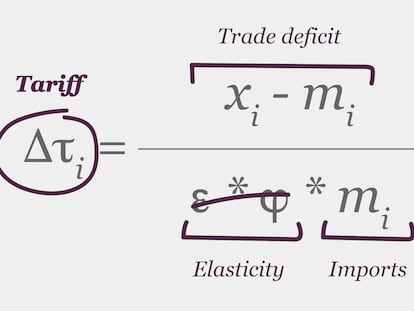The tariff boomerang effect: How Trump’s move could hurt international tourism
Canada and Mexico account for half of all travelers to the US and will face a new 25% tariff. The new measures also impact the three countries with the highest growth in visitors in 2024: China, India, and Japan

The trade war launched by Donald Trump — through the widespread imposition of tariffs on the United States’ main trading partners in an effort to reduce the country’s large trade deficit and boost domestic economic activity — could have a negative impact on tourism in the world’s largest economy.
The U.S. was the third most-visited country in 2024, welcoming 72.3 million travelers, and ranked first in tourism-related revenue, earning some $194 billion, according to the latest data from the World Travel & Tourism Council (WTTC).
While there’s no direct correlation, the imposition of tariffs, the retaliation by affected countries, and the broader economic fallout of this tariff war with key partners is fueling a growing backlash against the U.S. — one that could eventually translate into a tourism boycott. In February, when Trump first floated the idea of applying tariffs on Canadian exports to the U.S., the number of Canadians crossing the border by car dropped by 24% compared to the same period in 2024, and U.S. carrier United Airlines also sharply reduced its flights from Canada.
This trend has yet to emerge globally, but it’s not far-fetched when considering the overlap between countries targeted by the new tariffs and those that send the most tourists to major U.S. destinations.
In 2024, the two largest sources of tourists to the U.S. were Canada, with 20.24 million visitors, and Mexico, with 16.98 million. Together, they accounted for more than half of all inbound travel.
Both countries are now facing new 25% tariffs on their exports to the U.S. as of April 2. The negative implications for their businesses are clear: companies will be forced to raise prices, cut profit margins, or both. In response, both governments may consider imposing similar countermeasures.
Aware of the critical role these two countries play in both trade and tourism, the U.S. government has made an exception: the new tariffs will not apply to goods covered under the USMCA trade agreement. However, this only partially softens the blow. Mexico’s powerful auto industry will still be hit hard, and around 50% of the country’s exports to the U.S. will be affected.
The U.K. ranks third, with 4.03 million tourists, making up 5.6% of the total. So far, the country has ruled out any commercial retaliation against the U.S., in part because it was one of the least affected, receiving only a 10% tariff on its exports. Brazil, the sixth-largest source of U.S. tourists in 2024 with 1.91 million visitors (2.64% of the total), is in a similar situation.
The steepest tariffs target countries whose tourist numbers grew the most in 2024. China, which ranked tenth with 1.62 million visitors (2.24% of the total), saw its exports slapped with a 34% tariff. This could significantly hinder a promising and fast-growing market of high-spending tourists who tend to stay longer than average. Chinese tourism to the U.S. surged by 50% in 2024 — the highest growth among the top 10 countries, according to WTTC — and had been expected to continue expanding rapidly.
India and China, both in the Asia-Pacific region, experienced similarly strong growth in U.S.-bound tourism last year — up 24.3% and 21.4%, respectively. But while outbound tourism from Europe had already rebounded to pre-Covid levels by the end of 2023 and even reached record highs in 2024, Asia’s recovery has been slower due to ongoing travel restrictions and a focus on promoting domestic tourism.
The final two countries in the top 10 — Germany and France — rank fifth and eighth respectively, with 1.99 million and 1.7 million travelers. Like Spain, both are now subject to a 20% tariff on their exports to the U.S.
Sign up for our weekly newsletter to get more English-language news coverage from EL PAÍS USA Edition
Tu suscripción se está usando en otro dispositivo
¿Quieres añadir otro usuario a tu suscripción?
Si continúas leyendo en este dispositivo, no se podrá leer en el otro.
FlechaTu suscripción se está usando en otro dispositivo y solo puedes acceder a EL PAÍS desde un dispositivo a la vez.
Si quieres compartir tu cuenta, cambia tu suscripción a la modalidad Premium, así podrás añadir otro usuario. Cada uno accederá con su propia cuenta de email, lo que os permitirá personalizar vuestra experiencia en EL PAÍS.
¿Tienes una suscripción de empresa? Accede aquí para contratar más cuentas.
En el caso de no saber quién está usando tu cuenta, te recomendamos cambiar tu contraseña aquí.
Si decides continuar compartiendo tu cuenta, este mensaje se mostrará en tu dispositivo y en el de la otra persona que está usando tu cuenta de forma indefinida, afectando a tu experiencia de lectura. Puedes consultar aquí los términos y condiciones de la suscripción digital.
More information
Archived In
Últimas noticias
All the effects of gentrification in one corner of Mexico’s Colonia Roma
Palestinian reporter Youmna El Sayed: ‘My family told me I had to choose between being a journalist or a mother’
The new language of the workplace: Knowing how to ask AI questions is more important than using it
Russell Tovey: ‘I was advised many times not to come out, I don’t think there was many people who’d done that — and I feel really proud that I’m one of those that did’
Most viewed
- The low-cost creative revolution: How technology is making art accessible to everyone
- Christian Louboutin: ‘Young people don’t want to be like their parents. And if their parents wear sneakers, they’re going to look for something else’
- US sanctions against jailed cartel leader ‘El Marro’ highlight Mexico’s lack of control over its prisons
- Liset Menéndez de la Prida, neuroscientist: ‘It’s not normal to constantly seek pleasure; it’s important to be bored, to be calm’
- Cartels in Mexico take a leap forward with narco-drones: ‘It is criminal groups that are leading the innovation race’











































